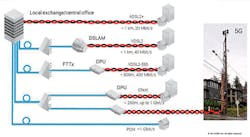Inclusive High-Speed Solutions —
I write what too many providers no longer care about: twisted pair copper. While the copper infrastructure can continue its long life delivering high-speed solutions today and tomorrow, these services have, in many cases, been underutilized and the copper hasn’t been well maintained. Focus and budgets are overly fiber-focused. While fiber is an excellent, reliable, and fast, product, it’s not the "be all, end all." Many smart providers maintain their copper, and see it as having a long-term place in their offerings.
I fully agree that the move to fiber is here today and will continue to be distributed well into the future. However, the future can and should include tapping into the thousands of miles of installed copper continuing to serve many consumers who depend on it either because they are in smaller, unserved communities, or because copper is part of an appropriate, cost-effective fit for their needs.
InvisiLight® Solution for Deploying Fiber
April 2, 2022Go to Market Faster. Speed up Network Deployment
April 2, 2022Episode 10: Fiber Optic Closure Specs Explained…
April 1, 2022Food for Thought from Our 2022 ICT Visionaries
April 1, 2022I’m a copper guy but I’m all about servicing customers with the right solution to fit their needs, whether they are a worldwide corporation or a farmer feeding our communities. I just want to see the best and fairest services and budgets distributed amongst all classes of customers.
What does Russ say?
Russ Gundrum (https://www.telecomproblemsolvers.com/ and https://www.linkedin.com/in/russgundrum), Principal Consultant at Telecom Problem Solvers and a long-respected voice in the industry, speaks of "copper phobia" as responsible for the almost exclusive fiber focus many companies exhibit. Russ notes: "The soothsayers claim you have to serve them with fiber. I don’t think so."
Attending a webinar led by Chris Dunford, Product Line Manager at EXFO, Russ discovered innovative topologies utilizing ADSL2+, VDSL2-35b, and G.fast to 5G deployments. (See Figure 1.) Services such as this are based upon copper and are deployed broadly in Europe.
Figure 1. As presented at an ISE Webinar Feb 13, 2019: Best Practices for Successful G.fast and VDSL2-35b to 5G Deployments. Chris Dunford, Product Line Manager, Physical Layer, EXFO.
During a discussion between Russ and Dr. John Cioffi, "father of DSL," CEO of ASSIA (https://www.assia-inc.com/), and Stanford Professor Emeritus of Engineering, Dr. Cioffi, shared his insights: "Europeans are much more aggressive with the use of their twisted pair facilities than anyone in the US."
Expanding on this thought Dr. Cioffi commented to me: "I believe that is beginning to change. The broad deployment of fiber is taking longer than expected because both costs higher than anticipated, and the consumer’s relatively low level of willingness to pay for higher speeds. These limitations and the recent wireless advances will lead many US Internet service providers to better leverage their existing copper and both licensed and unlicensed wireless assets, placing fiber only where business cases prove positive."
It’s good to see creative solutions such as the one described above from EXFO and Dr. Cioffi. This could provide a more democratic and cost-effective deployment of broadband. Meanwhile, Russ and I agree that, sadly, many of the people who live in smaller communities or in far-reaching rural areas, are left behind in the "fiber feeding frenzy" as fiber budgets are eating up funding that might go into products to serve all.
Russ also sees the dogged commitment to fiber as sometimes political: "Some of the large national providers brag about ‘homes passed’ with fiber when in fact they don’t really care if they get an FTTH customer or not. Their real intentions are to get fiber out there so they can serve 5G antennas and then offer high-speed broadband services to customers wirelessly in order to compete with the cable companies."
That said, in my 40+ years training and working on some of the toughest copper challenges, I have had the privilege to work with several customer-focused ILECs and co-ops who are providing excellent services and products to all customers. In fact, many of those I’ve worked with are ahead of the curve in deploying fiber while continuing to pay attention to copper-fed customers.
Next are some notes from my discussion with Forrest Collier from TEC, an excellent example of a provider that demonstrates a dedication to delivering the right solution for each customer, and to serving them fully.
Forrest Collier talks about the challenges
Forrest Collier, Director of Plant Operations at TEC (https://www.tec.com/ and http://www.linkedin.com/company/tec-inc) with services in several southern states, shares that they are largely on track with their copper-to-fiber transition plan. He cites the same concerns as other companies moving to fiber, including access to materials, new test sets, and training for fiber technicians. Looking at the future of their fiber install, Forrest comments, "I also believe our fiber plant will be used to help support the backhaul needs of 5G and other technologies that will emerge."
While broad distribution of fiber is key to TEC’s success, their overall plan includes maintaining the copper infrastructure particularly for the rural customers who may not have fiber for some time. TEC continues pushing higher speeds further out on copper.
The company is fortunate to have a strong base of talented copper technicians. However, they, along with most companies, admit it’s a growing struggle to hire well-trained copper technicians — they are generally an older group, and they are retiring.
Meanwhile, many of the younger techs aren’t learning the complex skills required to maintain copper; they see it as a dying technology, and they aren’t wrong. I am convinced we have many years of copper dependence ahead. We must support copper technicians with budgets for equipment and training. Having taught thousands of technicians over 40+ years, I know how complex location, repair, and maintaining, our very old copper
infrastructure can be. If you can find a good copper technician, hire them now, and pay them well!
Signing off
I lived in the country for a long time. We struggled with fixed wireless Internet with the signal bounced from our neighbor’s barn roof. It wasn’t that bad, although not reliable in bad weather, which isn’t uncommon in Oregon. When moving to a more populated community, I was excited about fiber through Frontier. The cable TV was awful as far as content and reliability — every month I was given a new modem. Additionally, paying for ultra-high-speed upload was unnecessary and expensive for our needs and the needs of all of our neighbors. Fiber is very reliable and is a great solution when the business case makes sense and is in well-populated communities that demonstrate a willingness to pay for higher speeds. However, for many communities, both large and small, fiber is best for the long haul with copper and its many technology advances serving the customers in their homes.
Like this Article?
Subscribe to ISE magazine and start receiving your FREE monthly copy today!
My projection for 2020 and beyond is that copper isn’t going away for a very long time, and I am hopeful for an increasing implementation of copper-to-wireless and fiber-to-copper, depending on the business case. Driven by needs of small communities and rural customers who deserve access to broadband, look to the ILECs and co-ops for innovative copper and fiber solutions! Please reach out to me with your thoughts: [email protected] or 831.818.3930.
About the Author






